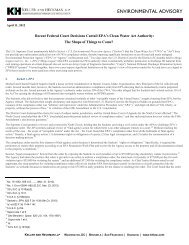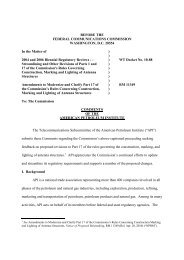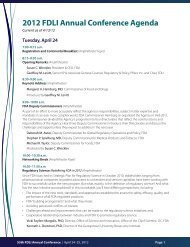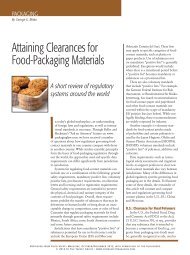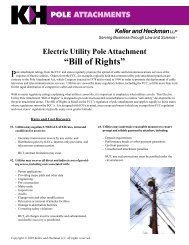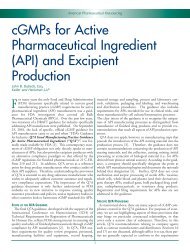A Practical Understanding of the Polymer ... - Keller Heckman
A Practical Understanding of the Polymer ... - Keller Heckman
A Practical Understanding of the Polymer ... - Keller Heckman
Create successful ePaper yourself
Turn your PDF publications into a flip-book with our unique Google optimized e-Paper software.
<strong>Polymer</strong> Exemption Requirements<br />
10<br />
not qualify any o<strong>the</strong>r version <strong>of</strong> <strong>the</strong> same polymer if it is water-absorbing. In short,<br />
<strong>the</strong> exclusion must never be violated by any version even if some versions satisfy<br />
this limitation.<br />
If possible, determine <strong>the</strong> dry mass <strong>of</strong> a sample <strong>of</strong> <strong>the</strong> polymer in question that<br />
is free <strong>of</strong> precursors and o<strong>the</strong>r associated substances. Then contact <strong>the</strong> sample with<br />
a quantity <strong>of</strong> water equal to twice <strong>the</strong> polymer’s dry mass. We suggest using normally<br />
available, deionized water. Record <strong>the</strong> pH <strong>of</strong> <strong>the</strong> water used to establish that<br />
<strong>the</strong> pH is within <strong>the</strong> usual bounds <strong>of</strong> neutrality. Reasonable conditions during <strong>the</strong><br />
contact would be one hour at room temperature. The nature <strong>of</strong> <strong>the</strong> contact should<br />
be such that <strong>the</strong>re is a reasonable opportunity for <strong>the</strong> polymer to absorb <strong>the</strong> water.<br />
Subsequently, physically separate <strong>the</strong> wet polymer from excess gross water.<br />
Determine <strong>the</strong> mass <strong>of</strong> <strong>the</strong> polymer plus whatever mass <strong>of</strong> water that has been<br />
absorbed and retained. If this wet mass is less than double <strong>the</strong> dry mass or more,<br />
<strong>the</strong> polymer is not sufficiently water-absorbing to be excluded from <strong>the</strong> exemption<br />
by this provision.<br />
The EPA has not considered how time, temperature, pH, water purity, apparatus,<br />
procedure, nature <strong>of</strong> <strong>the</strong> polymer, interpretation <strong>of</strong> data, kinetics, or o<strong>the</strong>r considerations<br />
will influence <strong>the</strong> results. If <strong>the</strong>re is significant water absorption, it might be<br />
prudent and appropriate to submit a suitable protocol and data to <strong>the</strong> EPA for<br />
approval before relying on any particular results.<br />
6. Reactive Functional Groups<br />
A reactive functional group (RFG) is defined as an atom or associated group <strong>of</strong><br />
atoms in a chemical substance that is intended or can be reasonably anticipated to<br />
undergo fur<strong>the</strong>r chemical reaction. This provision is expressed in <strong>the</strong> regulation as<br />
a limitation to <strong>the</strong> (e)(1) condition, not as an exclusion. Although <strong>the</strong> reactive functional<br />
group limitation it is not applicable to <strong>the</strong> (e)(2) and (e)(3) conditions, it<br />
might be better understood as an exclusion, albeit one that only applies to (e)(1).<br />
There was an RFG exclusion in <strong>the</strong> original polymer exemption. In <strong>the</strong><br />
amended exemption, <strong>the</strong> RFG exclusion, like <strong>the</strong> entire exemption itself, is more<br />
complex compared to <strong>the</strong> original version. None<strong>the</strong>less, it allows more polymers to<br />
be exempt.<br />
More polymers are potentially exempt due to both <strong>the</strong> exclusion’s sole applicability<br />
to <strong>the</strong> (e)(1) condition and o<strong>the</strong>r complicating refinements. In fact, <strong>the</strong><br />
refinements can be extremely complicated if one has different kinds <strong>of</strong> RFGs present<br />
in <strong>the</strong> polymer’s molecules. A “quick and clean” approach is to identify <strong>the</strong><br />
equivalent weight for all RFGs that will form an ionic or covalent linkage to an<br />
amino acid. If that equivalent weight is less than 5000 for all such groups combined,<br />
<strong>the</strong> polymer is probably excluded by this provision, but <strong>the</strong>re is hope that it<br />
is not excluded unless <strong>the</strong> equivalent weight is less than 1000.<br />
The (e)(1) limitation only applies when <strong>the</strong> polymer’s molecular weight is<br />
1000 or more, but less than 10,000 and <strong>the</strong> oligomer levels are less than 25 and 10




